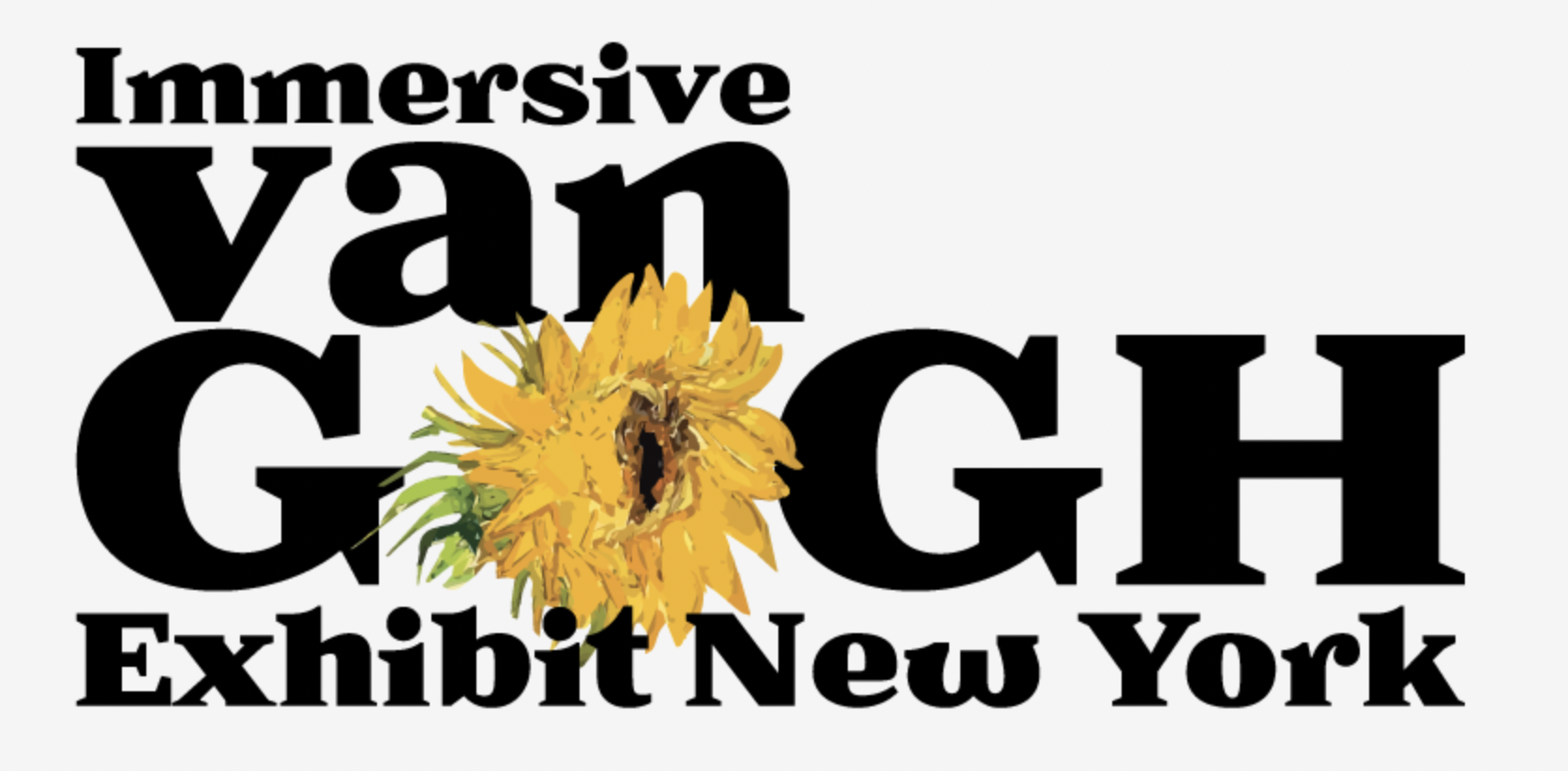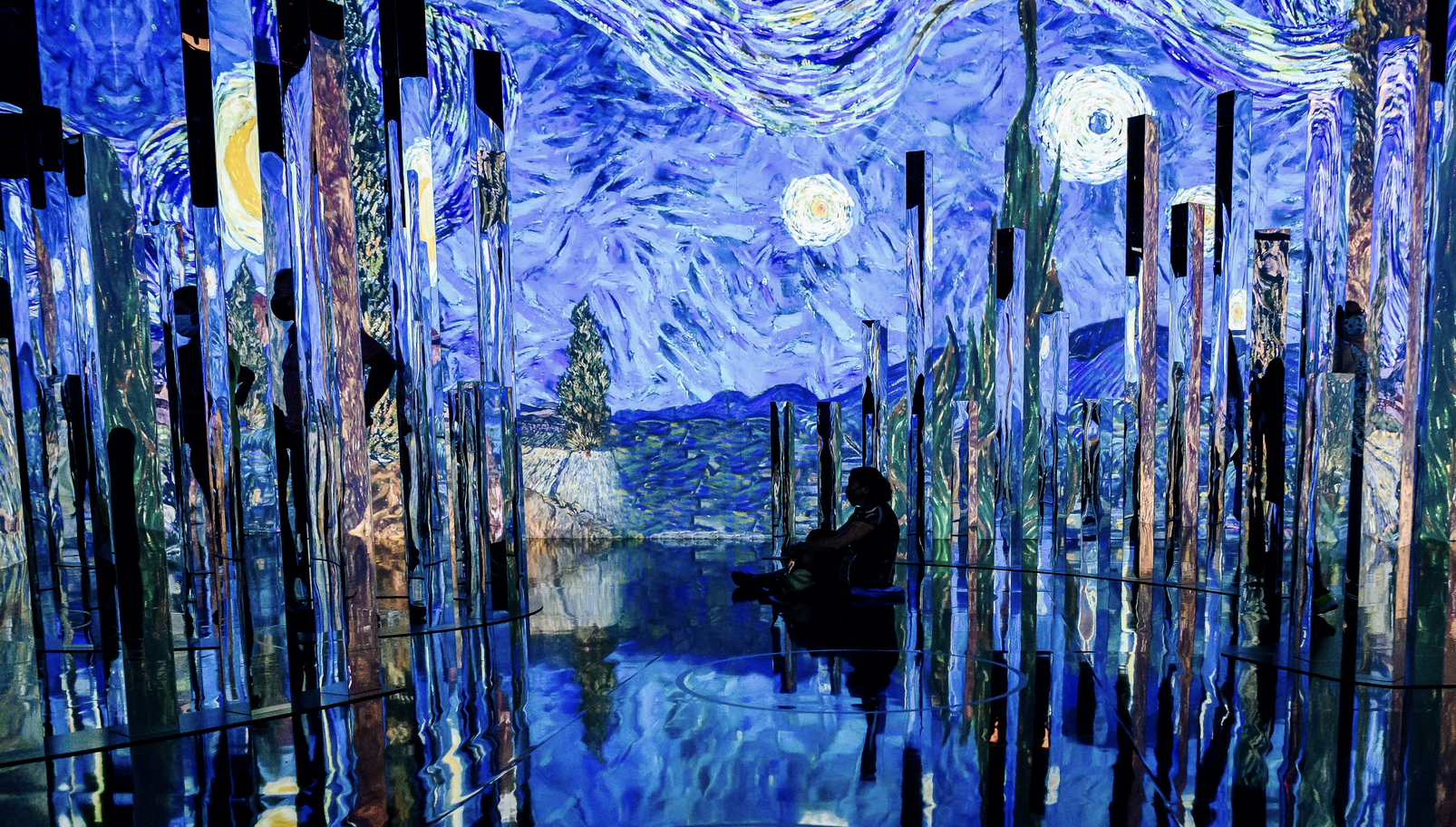New Yorkers Go van Gogh – Yes There are Two
By Sue Weston and Susie Rosenbluth – Two Sues on the Aisle
Immersive art has been described as allowing the viewer to become a part of something far greater than the body–human or artistic. It means absorbing oneself totally by standing within and not in front of the artwork. It creates an intimate relationship between the viewer and the artwork, a wordless experience of color and sound, transforming the venue into a canvas, where the viewer becomes one with the work. Now, in lower Manhattan, New Yorkers can submerge themselves in the works of Vincent van Gogh, on the East Side at “Immersive Van Gogh” located at Pier 36 (open until January 2nd), or on the West Side at “Van Gogh: The Immersive Experience,” located at 300 Vesey Street, near the World Trade Center.
Despite the similarity in name and content, these two van Gogh immersive experiences are separate and distinct, offering perspectives and insights into the acclaimed works which transformed the art world in the late 19th century.
Van Gogh’s story is often romanticized: a starving artist who struggled with mental illness, was supported by an adoring brother, and committed suicide. In these two exhibits, his history has been reconstructed by taking snippets from letters to his brother and then adding analysis by art historians. But his body of work speaks for itself, especially when each piece is blown up to near massive proportions, creating a sensory experience.
Why now are we being treated to two such exhibitions? Why not!
Move over Wikipedia and Experience Art
Visitors to Van Gogh: The Immersive Experience begin their encounter by climbing a staircase adorned with self-portraits of the artist even before they queue up at the box office. The lobby contains an enormous bust of van Gogh which is illuminated by colored lights. Viewers pass through a heavy curtain into a narrow corridor where the van Gogh story unfolds, complete with reproductions of paintings and even a short movie, presented in museum-esque format.
Here, you can learn about the life of this tortured genius, whose art has become a cultural statement, even though his work was rejected by most of the art world during his lifetime. Some of the insights offered by this exhibit were new (at least to us), such as the possible supposition that the cypress tree in Starry Night, connecting heaven and earth, might indicate that the artist may have been colorblind.
Connect with the Art
The pièce de résistance of both exhibitions is the sensory explosion that awaits upon entering a dark room in which projections set to music are shown on the floor and walls, interspersed with quotations. The creators of this living van Gogh immersion transform the artist’s paintings into a multi-sensory experience, bringing shapes to life, set afloat in a sea of music. The experience offers a powerful onslaught of sound, motion, and color, as viewers recline on beach chairs, benches, or directly on the floor, becoming active observers swept over by waves of art and expression.
While those expecting the thrill of seeing the original Starry Night are probably better served by visiting the Museum of Modern Art, where this treasure is shown in all its glory, those who attend these immersive art exhibitions quickly understand there is more to art here than mere reproductions of paintings. In the entry corridor, visitors can snap pictures of themselves in a van Gogh environment; they can enter a replica of van Gogh’s yellow bedroom in Arles and marvel at the 3-D vase which becomes the canvas displaying a series of floral paintings. At the coloring station, children of all ages (and the adults with them) can create masterpieces that will then be projected on the wall, and the virtual-reality experience that takes them through Arles and allows them to walk through picture frames to place themselves inside familiar paintings should not be missed.
Although Immersive Van Gogh shares many of the same imagery, the interplay of music and imagery created different undertones and interpretations. Common themes included crows, the lights of Starry Night, the asylum in which the artist spent his last days, haystacks, tree roots, sunflowers, boats, and elements of the Japanese influence. The musical accompaniment heightens the sensory experience, bringing with it a subtle but powerful connection, making the viewer one with the work.
The venue, located at New York’s Pier 36, offers patrons more than 500,000 cubic feet of animated projections. Entering the expansive space, under the watchful eyes of a massive van Gogh self-portrait, visitors’ sense of self is immediately dwarfed by the majesty, the power of the space. Highly recommended is a trip up the stairs to a raised platform. From there, the sight of massive paintings, projected onto the cavernous hanger, creates an intimacy, a unique sensory experience, which offers the observer a sense of motion, an almost out-of-body connection, in which other patrons become part of the art. It’s very different from the floor view.
All in all, it’s safe to say, the two van Gogh exhibits offer very different experiences, each providing its own interpretation and neither anything like the originals hanging in MOMA and the Metropolitan Museum of Art. In an era of technology, immersive art connects with our imagination, bringing beauty and creativity to life.
Classics Rediscovered
This new breed of art adds a Disney-like experience, making it relatable across all generations, ethnicities, and demographics, without words and without explanation. Immersion may be the key to capturing the imagination and giving society a cultural connection. The producers of these exhibits may be influencing our perspective, but that’s okay because they are introducing these pieces to a new generation of art lovers.
Van Gogh was both an Impressionist and a post-Impressionist. The first was a movement that changed paintings from attempts to reflect life to recreating it by adding bright colors, bold brushstrokes, and captured movement. Post-impressionism ignored the rules in order to distort forms, adding abstraction, and capturing the imagination. Van Gogh’s Starry Night may be the most iconic painting typifying this style.
A Great Evening Out
These exhibits provide destinations that are family-friendly and great for observant-Jewish date nights, opportunities to expand perspective while spending a few hours distracted from reality. Still dealing with the pandemic, many of us are dealing with some of the same issues van Gogh faced: isolation, the need for acceptance, and the search to relate to the world around us. Had van Gogh lived longer, would his artistic genius have been embraced by society? We will never know, but the immersion experience is becoming part of popular culture, providing a 21st-century spin to artwork created in the late 1800s. The Van Gogh experience is spreading across the country and the globe, and it may reinvent art appreciation.
It’s time for you to join the fun! Go Go van Gogh, and explore your artistic side.
***
Two Sues on the Aisle bases its ratings on how many challahs it pays to buy (rather than make) in order to see the play, show, film, or exhibit being reviewed. 5 Challahs is our highest rating.
Immersive Van Gogh and Van Gogh: The Immersive Experience received a 5 Challah rating











